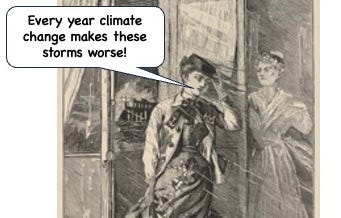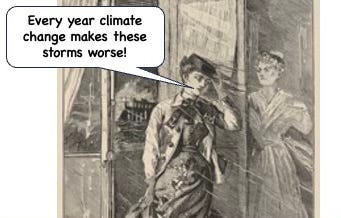Climate change brings more variable rainfall and more headaches
Many U.S. cities are unprepared for new challenges posed by climate driven weather.
Before I get underway, I’d like to thank fellow Substacker for posting the scientific paper that serves as the basis of much of this edition of The Green Dispatch. Jonathan produces Predirections, a fine Substack on biodiversity and other environmental concerns.
Back in June, I looked at some effects of climate change in the U.S. I concentrated mostly in the observed changes in the ranges of migratory birds. Today, I’m looking at the weather: how it has changed because of climate change and how those changes affect our infrastructure.
Climate scientists predicted long ago that pumping gigaton after gigaton of CO2 into the atmosphere would make for more variable weather. Perhaps the annual rainfall for a city or state might not change much, but the science predicted more variability to that rainfall. Rainstorms would drop more rain, with heavier storms and downpours, while dry spells and droughts would be longer and drier.
Scientists explain that a warmer atmosphere worldwide has an increased moisture-holding capacity. The increased moisture and increased energy in the atmospheric system gins up the globe’s precipitation systems, producing more extreme storms and downpours as well as deeper droughts.
A team of researchers looked at worldwide precipitation patterns over the last century and found this prediction is already manifesting itself, with increased precipitation variability particularly pronounced in Europe, Australia, and the eastern portion of North America. Other areas may have similar trends, but the data wasn’t as reliable.
Folks on the ground, people who have lived in communities for decades, farmers raising crops, and city planners who have to manage stormwater and floods will confirm the scientific finding with what they themselves have observed over the decades.
In the 48 contiguous states of the U.S. over the last 100 years, annual precipitation has increased by 0.18 inches per decade, with the Southwest seeing an overall decrease in precipitation. Over the last 50 years, throughout the Midwest, annual precipitation has increased by five to ten percent, not a great big change. But rain is coming down more in downpours or heavy storms. During the Midwest’s four wettest days of the year, rainfall has increased by 35 percent. Floodwaters during the worst floods have increased by 20 percent.
It is difficult to tie climate change to any one event, a single downpour or a single dry spell. Yet patterns are emerging. In July 2023, heavy rains besieged Acworth, New Hampshire, washing out 32 roads in that community. Just two years before, heavy July rains washed out the same 32 roads. Residents sense a trend in the weather and fear they won’t be able to keep up with the extreme weather they see coming their way.
Philadelphia has girded itself for greater stormwater runoff with its Green City Clean Waters program, a system of green infrastructure such as porous pavement and rain gardens that allow water to soak into the ground rather than run off into storm drains and streams. Despite these efforts, the stormwater problems of Philadelphia have only increased because more and heavier downpours now drench the City of Brotherly Love.
Other eastern cities are also finding their stormwater systems inadequate. In 2023, Boston received about 55 inches of rain, a bit wetter than an average year, yet stormwater released to the Charles River that year was five times the allowable limit under Boston’s stormwater control plan. Stormwater managers for the Charles River Watershed Association recognize that the problem arises from roughly the normal amount of rainfall falling during fewer storms.
Pittsburgh is currently updating its stormwater program to match its increased rainfall and more intense downpours. Vanderbilt University School of Engineering warns that a recent extreme storm in Kentucky that dropped 17 inches of rain in 24 hours is in part due to climate change and is a harbinger of things to come. Stormwater backs up regularly in Cincinnati because of climate change, and the rest of the state of Ohio is flooding more frequently.
This past January, San Diego, where I live, experienced one of the worst downpours in the city’s history. As I recall, some parts of town received up to four inches of rain. This is in a city that sometimes receives fewer than four inches of rain in an entire year. I cannot say how much climate change exacerbated this particular storm, but California is well known for having extreme “whiplash” weather: long periods of dry interspersed with sometimes very wet weather. Yet these whiplashes are becoming more extreme and bear the fingerprint of climate change.
X (You can find me on that thing formerly known as Twitter.)
Climate change is taxing Boston’s stormwater system. Do you still love that dirty water?






There is no doubt the climate crisis is causing accelerated glacial shrinkage. Additionally melting permafrost is freeing up scree facilitating devastating avalanches. https://www.berneroberlaender.ch/brienz-nach-dem-unwetter-als-der-bach-zur-naturgewalt-wurde-530996832303